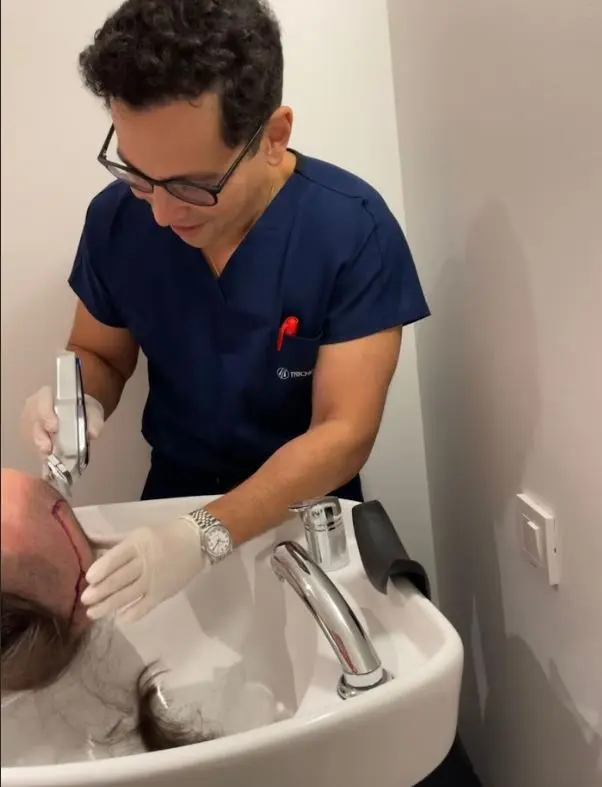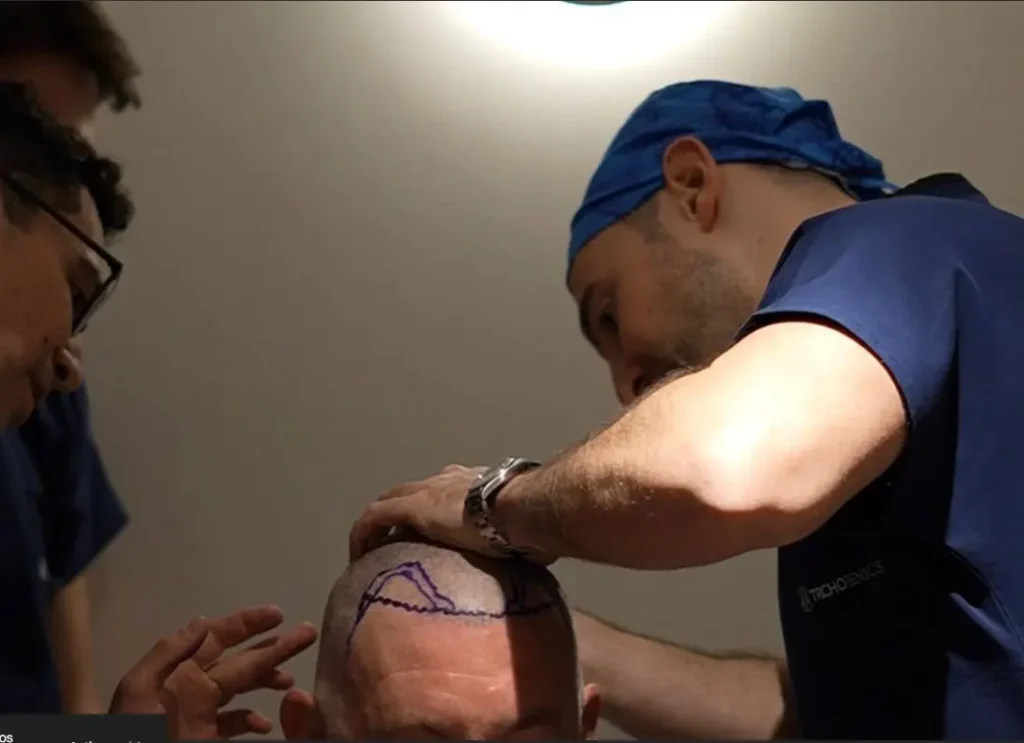You don’t always need to shave your entire head before undergoing a hair transplant. The technique your doctor uses and the extent of your hair loss determine whether you need to shave.
For example, with advanced FUE methods, surgeons can work around your hair. They extract follicles from small donor areas that longer strands cover. If you are wondering, “Do you have to shave your head for a hair transplant?” The answer is often no.
This is especially true with modern no-shave FUE procedures. These methods provide natural and discreet results. At Trichogenics in Greece and Israel, every surgery is doctor-performed to ensure safety, precision, and a natural appearance from day one.
At Trichogenics, Dr. Asi Peretz and Dr. Eric Peretz often hear patients ask, “Do I need to shave my head for a hair transplant?” The answer depends on the method.
Key Takeaways
- You don’t always need a full shave before a procedure—modern FUE hair transplant techniques allow selective trimming of the donor area while preserving your existing hair.
- If you’ve wondered, “can I get a hair transplant without shaving my head,” the answer is yes; no-shave FUE methods make it possible to restore density discreetly.
- Clinics in Greece and Israel, like Trichogenics, offer medically supervised surgeries performed only by doctors, unlike the unsafe and poorly regulated clinics in Turkey.
- The no-shave hair transplant procedure requires more time and precision but delivers natural results, faster recovery, and no visible shaving marks.
- Choosing an experienced hair transplant surgeon such as Dr. Asi Peretz ensures safe treatment, strong hair growth, and long-lasting results tailored to your individual needs.
The Short Answer: You Don’t Always Have to Shave Your Head
Most patients don’t need a complete shave before a hair transplant procedure. Thanks to refined FUE hair transplant methods, surgeons can work around your existing hair while targeting specific thinning areas.
Only small donor zones may be trimmed for precision. This approach helps maintain your appearance throughout recovery, especially for those with longer hair or professional obligations.

Do You Need to Shave Your Head for FUE or No-Shave Hair Transplants?
Why Some Clinics Recommend Partial Shaving
In a traditional FUE, doctors trim the donor area—the region at the back or sides of the scalp where healthy follicles are extracted.
Partial shaving allows the hair transplant surgeon to clearly view and collect strong donor hair units. It also ensures clean implantation in the recipient area, where the new transplanted hair will grow naturally.
Shaved vs Unshaven FUE — Key Differences
- Shaved FUE: Entire scalp or donor section shaved for faster access and easier extraction.
- Unshaven FUE (“No-Shave”): Hair kept intact except for tiny trimmed patches hidden beneath longer strands.
The unshaven technique is more discreet but takes longer to perform, requiring steady precision from an experienced hair transplant surgeon.
Who Is a Good Candidate for the No-Shave Technique?
You may be a good candidate if you:
- Have longer hair that can cover donor spots.
- Need minimal grafts for local thinning.
- Prefer to avoid visible post-surgery changes.
- Patients with severe hair loss or limited healthy hair may still benefit more from a shaved FUE to achieve full coverage.
@trichogenics Do you need to shave your hair to get a hair transplant? Dr Asi Peretz explains. #trichogenics #hairtransplant #hairtransplantsurgery #hairtransplantturkey #hairtransplantgreece #hairloss #hairlosssolutions #hairlossremedy #hairfall #hairfallsolution #fyp
♬ original sound - Trichogenics
Female Hair Transplant Without Shaving — How It Differs
For women, full shaving is rarely necessary. Surgeons isolate small hidden donor zones behind the ears or lower scalp. The hair transplant surgery proceeds seamlessly without altering the overall hairstyle.
This method offers privacy and comfort while ensuring long-term hair growth that looks completely natural.
What to Expect from a No-Shave FUE Procedure
Step-by-Step Overview
- Consultation and Planning: The doctor examines the donor area, recipient area, and surrounding hair.
- Extraction: Using micro-punch tools, individual follicles are removed while keeping surrounding strands intact.
- Implantation: The follicles are inserted into thinning areas to restore density.
This hair transplant procedure requires patience and precision but preserves your natural appearance from day one.
Recovery Time and Aftercare Tips
Recovery after a hair transplant without a shaving head is smooth. You can return to routine activities within days. Follow your doctor’s guidance:
- Keep the scalp clean and avoid scratching.
- Sleep with your head elevated for the first few nights.
- Use prescribed products to protect transplanted hair and encourage healthy hair growth.
Risks, Side Effects, and Healing
Minor swelling or redness can appear for a few days. Choosing an experienced medical team—like Trichogenics—minimizes these risks.
Each hair transplant surgery is performed under strict standards in our clinics in Greece and Israel, ensuring sterile conditions and safe healing.
Benefits, Limitations, and Costs
Aesthetic and Lifestyle Advantages
A hair transplant without shaving your head lets you maintain confidence throughout the process. No visible bald patches, no drastic image change. It’s ideal for professionals or anyone seeking subtle improvement.
Is the Cost Higher for No-Shave FUE?
Yes, slightly. The no-shave FUE takes longer and demands advanced skill. But the results—natural, hidden, and doctor-performed—justify the investment.
Clinics in Turkey may offer lower prices, yet safety and quality often suffer. Turkey’s hair transplant industry lacks regulation, and many operations are performed by unlicensed technicians.
In contrast, Trichogenics guarantees full medical supervision by Dr. Asi Peretz and Dr. Eric Peretz, both certified professionals who perform every procedure themselves.
That level of care cannot be replicated in unsafe, unregulated environments abroad.
Expertise and Safety in No-Shave Hair Transplants
Doctor-Performed Procedures at Trichogenics
Every operation is personally led by our founders, Dr. Asi Peretz and Dr. Eric Peretz. Their decades of experience in FUE hair transplant ensure precision, safety, and consistent results. Patients receive tailored plans based on the condition of their donor area, recipient area, and overall scalp health.
Ensuring Safety and Natural Results
At Trichogenics, each hair transplant surgery follows strict medical protocols. We use advanced imaging to analyze existing hair, optimize graft placement, and protect the surrounding hair for seamless blending.
Our goal is a durable, natural-looking outcome that restores confidence without risk.
Common Questions About Unshaven Hair Transplants
Will People Notice I Had a Hair Transplant?
Most patients report that no one notices. Because existing hair hides the donor spots, the change appears gradual as hair growth resumes. Friends may see you looking refreshed, not “operated on.”
How Soon Will Hair Growth Be Noticeable?
New hair growth typically begins around three months after surgery, with visible improvement by month six.
Full density develops between nine and twelve months. Maintaining good scalp hygiene and following post-operative advice helps protect your transplanted hair and encourages strong regrowth.
Your Next Step Toward Natural Hair Restoration
If you’ve wondered, “Do I need to shave my head for a hair transplant?” The answer is clear: not always.

At Trichogenics, our clinics in Greece and Israel combine medical expertise with advanced no-shave FUE techniques to deliver safe, natural results. Avoid risky trips to Turkey, where poor regulation and low-cost operations endanger patients.
Choose a clinic where certified doctors like Dr. Asi Peretz perform your procedure from start to finish—restoring both your hair and your confidence safely.



